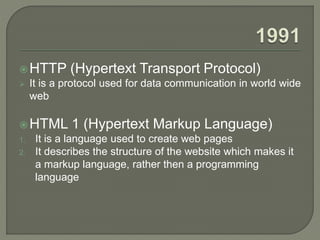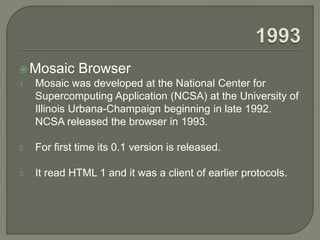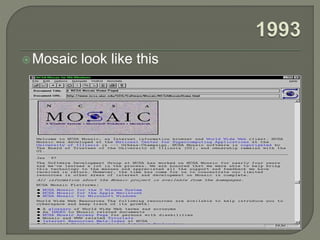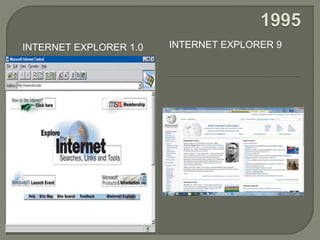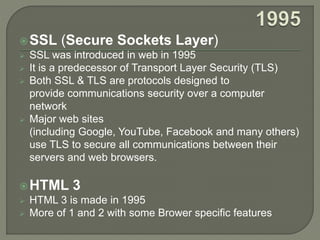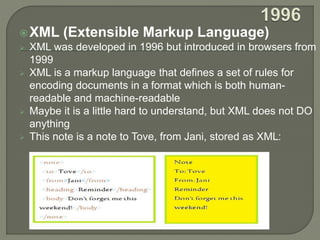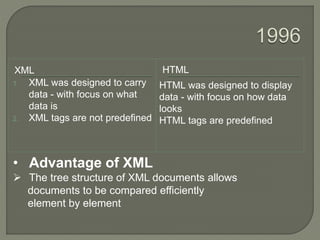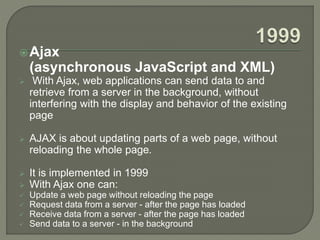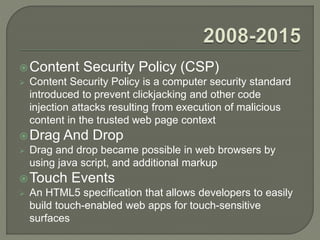Evolution of the web
- 2. HTTP (Hypertext Transport Protocol) It is a protocol used for data communication in world wide web HTML 1 (Hypertext Markup Language) 1. It is a language used to create web pages 2. It describes the structure of the website which makes it a markup language, rather then a programming language
- 3. Mosaic Browser 1. Mosaic was developed at the National Center for Supercomputing Application (NCSA) at the University of Illinois Urbana-Champaign beginning in late 1992. NCSA released the browser in 1993. 2. For first time its 0.1 version is released. 3. It read HTML 1 and it was a client of earlier protocols.
- 4. Mosaic look like this
- 5. HTML 2 HTML 2 is released in 1994. The feature of stylized text and table is introduced in it Cookies are introduced Cookie is a small piece of data sent from a website and stored in the user's web browser while the user is browsing it. Every time the user loads the website, the browser sends the cookie back to the server to notify the user's previous activity. These were 1st time implemented in Netscape browser in 1994.
- 6. Netscape Browser Netscape browser build and its 1st and 2nd (0.9 & 1.0) versions was released in 1994 It has high speed then Mosaic browser and it was free although NCSA released 2nd version of Mosaic.
- 7. NetScap 1.0
- 8. Opera Browser It was internally and limited released in 1995. Opera web browser began in 1994 when it was started as a research project at Telenor. In 1995, the project branched out into a separate company named Opera Software ASA, with the first publicly available version released in 1996 Opera has undergone extensive changes and improvements, and introduced notable features such as Speed Dial. It has multiple document interface(MDI) and sidebar, which made browsing several pages at once much easier
- 9. Opera 1.0
- 10. Internet Explorer Microsoft has developed eleven versions of Internet Explorer for Windows from 1995 to 2013. It has also developed Internet Explorer for Mac, Internet Explorer for UNIX and Internet Explorer Mobile for Apple Macintosh, Unix and mobile devices respectively It was modeled on NCSA’s Mosaic browser but did not use its source code
- 11. INTERNET EXPLORER 1.0 INTERNET EXPLORER 9
- 12. SSL (Secure Sockets Layer) SSL was introduced in web in 1995 It is a predecessor of Transport Layer Security (TLS) Both SSL & TLS are protocols designed to provide communications security over a computer network Major web sites (including Google, YouTube, Facebook and many others) use TLS to secure all communications between their servers and web browsers. HTML 3 HTML 3 is made in 1995 More of 1 and 2 with some Brower specific features
- 13. JavaScript JavaScript was originally developed by Netscape in 1995 JavaScript is most commonly used as a client side scripting language. This means that JavaScript code is written into an HTML page. It has an application programming interface (API) for working with text, arrays, dates and regular expressions JavaScript is not the same as Java. I repeat: JavaScript is not the same as Java. It was first time implemented in NetScap in 1996 and later on it was adopted by Microsoft and was implemented in Internet Explorer’s version 3 in 1996 It was implemented by Opera in 1997
- 14. Flash Adobe Flash (formerly called Macromedia Flash and Shockwave Flash) is a multimedia and software platform It is used for creating vector graphics, animation, browser games, rich Internet applications, desktop applications, mobile applications and mobile games Flash displays text, vector and raster graphics to provide animations, video games and applications It allows streaming of audio and video, and can capture mouse, keyboard, microphone and camera input It was developed in 1995 but implemented in Browsers in 1996
- 15. XML (Extensible Markup Language) XML was developed in 1996 but introduced in browsers from 1999 XML is a markup language that defines a set of rules for encoding documents in a format which is both human- readable and machine-readable Maybe it is a little hard to understand, but XML does not DO anything This note is a note to Tove, from Jani, stored as XML:
- 16. XML HTML 1. XML was designed to carry data - with focus on what data is 2. XML tags are not predefined HTML was designed to display data - with focus on how data looks HTML tags are predefined • Advantage of XML The tree structure of XML documents allows documents to be compared efficiently element by element
- 17. HTML 3.2 And HTML 4 HTML 3.2 and HTML 4 were introduced in 1997 A re-evaluation of 3. Some clutter were removed that arrived in 2 and 3.
- 18. CSS (Cascading Style Sheets) 2 CSS is a style sheet language used for describing the presentation of a document written in a markup language CSS is designed primarily to enable the separation of document content from document presentation, including aspects such as the layout, colors, and fonts This separation of formatting and content makes it possible to present the same markup page in different styles for different rendering methods It is developed in 1998 but implemented in 1999
- 19. Ajax (asynchronous JavaScript and XML) With Ajax, web applications can send data to and retrieve from a server in the background, without interfering with the display and behavior of the existing page AJAX is about updating parts of a web page, without reloading the whole page. It is implemented in 1999 With Ajax one can: Update a web page without reloading the page Request data from a server - after the page has loaded Receive data from a server - after the page has loaded Send data to a server - in the background
- 20. In 2003 APPLE launches safari browser The Mozilla Firefox project was created by Dave Hyatt and Blake Ross in 2004 Opera released opera mini for mobile in 2005 Apple released 1st i-phone with mobile version of safari 3 in 2007 NetScap discontinued in 2007. The usage share of Netscape had fallen from over 90 percent in the mid-1990s to less than one percent by the end of 2006
- 21. Chrome browser was launched in 2008 HTML 5 HTML5 is a markup language used for structuring and presenting content on the World Wide Web It was finalized, and published, on 28 October 2014 by the World Wide Web Consortium (W3C) CSS3 CSS3 has been split into "modules". It contains the "old CSS specification" (which has been split into smaller pieces). In addition, new modules are added
- 22. Content Security Policy (CSP) Content Security Policy is a computer security standard introduced to prevent clickjacking and other code injection attacks resulting from execution of malicious content in the trusted web page context Drag And Drop Drag and drop became possible in web browsers by using java script, and additional markup Touch Events An HTML5 specification that allows developers to easily build touch-enabled web apps for touch-sensitive surfaces

